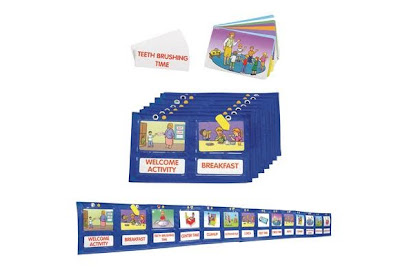Activity Idea: Animal Parade
 Halloween offers a great opportunity for bringing dramatic play into the classroom. Afterall, Head Start QuickSource® teaches us that "children learn through play. By assuming different roles, children have the opportunity to work out solutions to problems, practice new skills, and interact with others."
Halloween offers a great opportunity for bringing dramatic play into the classroom. Afterall, Head Start QuickSource® teaches us that "children learn through play. By assuming different roles, children have the opportunity to work out solutions to problems, practice new skills, and interact with others."
Here's an activity called Animal Parade that helps children discover the wonderful world of animals with art and dramatic play. Children will create animal masks and march in an animal parade. The goals of this activity are to participate in a variety of dramatic play activities that become more extended and complex, and to encourage the development of children's imagination and creativity.
Gather your materials: For this activity you will need: masks in the shape of animals or paper plates; glue; paint; animal pictures; collage materials.

Before you get started: Show the children photographs of real animals. If you don't have classroom photos, you can use photos out of a nonfiction children's book or a nature magazine. Talk about the characteristics of each animal. For example, pelicans have a very large beak, lions have a large mane of fur, elephants have a large trunk, etc. Ask the children to make the sound of each animal.
Let's get started!
1) Invite the children to make their own animal mask. 

2) Give each child a mask (or paper plate) and plenty of arts and crafts materials, such as feathers, crinkle paper (to make a lion's mane), paint, etc.
3) Help the children use the materials to create their animal mask.
4) Once the children have finished making their masks and all the paint and glue have dried, have an animal parade. Lead your line of animals on a march through the classroom or outside.
Furthermore: Use the masks again at circle time. Invite the children to pretend to be animals grazing or wandering around their natural habitat. Let them get up and scatter around the room. When you call for them with their animal sound, they must return back to the circle.
 If using POCET™, this activity correlates to Developmental Guideline: CA6: Plans and Works Independently through the Process of Art Activities. It also correlates to Developmental Guideline: CA8: Participates in Dramatic Play by Using Materials to Create Different Roles and Situations.
If using POCET™, this activity correlates to Developmental Guideline: CA6: Plans and Works Independently through the Process of Art Activities. It also correlates to Developmental Guideline: CA8: Participates in Dramatic Play by Using Materials to Create Different Roles and Situations. For more developmentally-appropriate activities, visit Teacher QuickSource® and browse through all age areas, including Preschool, Kindergarten, Infant & Toddler, and Head Start. Don't forget to explore activities promoting environmental awareness at Environmental QuickSource®, too!
Labels: animals, arts and crafts, circle time, classroom, creative, discount school supply, dramatic play, fine motor skills, habitats, halloween, Pocet, teacher resources





 The Preschool Observation Checklist and Evaluation Tool (POCET) was created to assist early childhood educators in organizing and maintaining an assessment system to monitor each child's development and to guide instructional practices. This individualization tool is organized to support any preschool curriculum chosen for the classroom. POCET is divided into six easy steps and two binders, and includes materials to individualize instruction for up to 25 children.
The Preschool Observation Checklist and Evaluation Tool (POCET) was created to assist early childhood educators in organizing and maintaining an assessment system to monitor each child's development and to guide instructional practices. This individualization tool is organized to support any preschool curriculum chosen for the classroom. POCET is divided into six easy steps and two binders, and includes materials to individualize instruction for up to 25 children.
